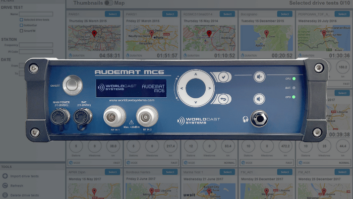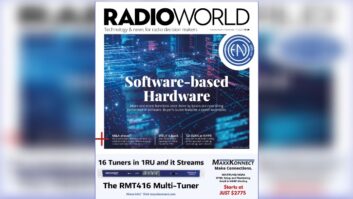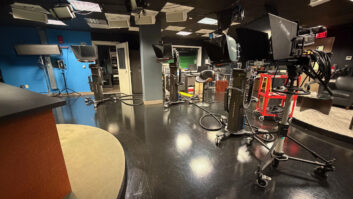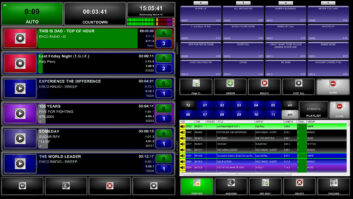The future of radio newsgathering may be contained in a stamp-sized device not much bigger than a thumbnail.
Although most serious street reporters use a combination of MiniDisc and cassette recorders to gather sound, that could well change in the next few years – perhaps sooner.
To help you manage that change before it manages you, here’s an overview of how audio flash card recorders work, featuring some operational considerations that should be addressed before writing a check or taking out the plastic, and a listing of models.
Reporters need speed, reliability and functionality in the field; the Flash card recorder solves those issues.
How they work
(click thumbnail)AEQ’s DR-100
Audio flash card recorders write (record) audio files (or tracks) to removable media called CompactFlash cards, which were made popular in digital photography and are readily available. The cards have a capacity that ranges from 32 MB to 4 and 8 GB, which is bigger than some laptop hard drives.
Depending on menu selection, the amount of audio is a function of format and sample size. The ones seen at NAB2005 will record in MP3 format, which yields hours on even the smallest CF cards (64 MB and above), and in uncompressed .WAV format, which yields better audio quality at the expense of space on the CF card.
(click thumbnail)Edirol’s R-1
The recorders have combinations of microphone, line and digital inputs, with provisions for automatic recording level control, manual recording level control and manual recording level control with a limiter, depending on the model. They will record CD-and-better quality audio. The recorders have no moving parts except for controls and switches. Some will fit in your pocket; most will hang comfortably off your shoulder.
Some have XLR inputs for microphones and phantom power for condenser models, some have 1/8-inch TRS jacks for microphone inputs and others have microphone input pads (-20 dB). All have some sort of built-in microphone. The units also include RCA analog or 1/8-inch TRS jacks for line inputs, and S/PDIF digital coaxial inputs and outputs.
(click thumbnail)PocketREC
Units are powered by AC adapters and standard AA batteries. Some have rechargeable nickel-cadmium (NiCd) and nickel metal hydride (NiMH) battery packs. I came across one powered by a cell phone battery.
Easing life in the field
These recorders can be used as standalone audio recorder/players, or connected to telephones, codecs and loops to send analog sound. The reporter can access the cuts using fast forward and rewind buttons – like a CD player, no shuttling of tape – and then play the cuts as needed.
Some machines will allow the reporter to set up a series of cuts in an “edit decision list,” which will take advantage of random access, even across separate and contiguous tracks, and play the cuts in a defined order, which reporters do when selecting cuts of actuality for news and sports feeds. What usually takes two machines can be accomplished with one. The process is significantly faster than shuttling through analog tape.
(click thumbnail)Marantz 671
Some units will give the capability of recording two mono tracks, one at normal volume and one at -20 dB lower. So if you are recording where the ambient sound level is high, you have a backup in case the main track is over modulated.
Flash card recorders have another advantage. With other formats, audio has to be recorded (rendered) in real time into the audio editing program on a laptop, then edited and prepared for transmission by file transfer protocol or e-mail. With the flash card audio recorders and their USB interfaces, the time spent rendering audio into the laptop decreases dramatically.
In the case of clean files that don’t need editing, those files can be transferred or attached to e-mails just like completed audio files on a hard drive. In the case of an interview of 5 to 10 minutes, a reporter with one of these machines can be editing files within two minutes, while the competitor is rendering audio into a laptop for editing, or shuttling through analog tape to find cuts of actuality.
(click thumbnail)HHB FlashMic
One other thing: the CF cards also can be inserted into card readers in other machines for access to the files. You can also transfer files by copying them to a USB jump drive, for instance.
Considerations
Generally speaking, flash card recorders will cost more than cassette recorders and “pro-sumer/consumer” MD recorders with microphone inputs, and less than higher-end MD recorders and DAT machines. One wouldn’t classify this as a throwaway, non-depreciable recorder.
(click thumbnail)Nagra Ares BB+
The return on investment can be measured by the time saved by a field reporter, which may translate into competitive advantage of being first to broadcast a report while the competition is still processing sound, and the time and money saved on maintenance and upgrades, some of which are available as a download from the respective company’s Web site.
The recorders with XLR inputs will accept easily available XLR M-F connector cords. Those recorders with 1/8-inch TRS microphone jacks can still take advantage of external microphones as long as a connecting cord with high strength and low hang weight is used. CF cards are available almost anywhere, but like most items research yields the best price.
Most of the recorders come with a standard 64 MB CF card. The minimum we use is 256 MB, and we keep the 64 for backup. Like anything else, more is better (at the right price).
Flash Card RecordersSeveral manufacturers are shipping, or plan to ship, flash-card capable audio recorders.
D & M Professional: Marantz PMD 660; Marantz PMD 670; and Marantz PMD 671; Web: www.d-mpro.com
AEQ USA: DR-100; Web: www.aeqbroadcast.com
Edirol Corp.: R-1; Web: www.edirol.com
PocketRec; Web: www.pocketrec.com
Nagra USA: ARES-M; ARES BB+; and ARES PII+; Web: www.nagraaudio.com
Maycom HandHeld Recorder; Web: www.bradleybroadcast.com
HHB USA: FlashMic; Web: www.sennheiserusa.com
If your company offers a Flash card recorder omitted from this list, write to us at [email protected] with product information.
The learning curve would likely be kind of steep for someone who’s replacing a cassette machine or MD used to play sound over a phone, and less so for those of us who use a laptop in the field. Quality time with the instruction manual is necessary to take full advantage of all the available options – and it’s better to do this at leisure than on deadline.
Setting record levels is important because unlike the MD, the flash card recorders don’t have a lossy compression-recording scheme. But the AGC on these units will help you in a “run and gun” situation.
When you replace four and eight alkaline batteries at a time, that cost might prompt you to look closely at rechargeable batteries, whether individual or battery packs. It’s been our experience that NiMH batteries last much longer. Motor Sports Radio Network has two sets of NiMH batteries that have lasted almost three years in our MD units.
Moving product
So how are they selling? John Lynch of BSW in Tacoma, Wash., sees this from two viewpoints: as a senior sales representative for the company and as a power user who produces audio projects for the Unlimited Light Hydroplane Racing Association.
“When the Marantz PMD 660 came out,” said Lynch, “BSW ordered 200 of them. (The shipment) took four months to arrive. Once it did, all the units were sold within two weeks. That was one of our biggest product introductions, and we’ve sold units to podcasters and major chains, once they get the purchase requests through corporate channels.”
They continue to be a very popular item,” he said. Lynch’s audio projects are recorded on flash card recorders and can be heard at www.ulhra.org
Lynch adds, “The portable cassette business has shrunk,” from his standpoint. “You will still likely see reporters using cassette recorders in the field, simply because they are more familiar with them. But once those reporters leave the business, the cassette recorders they used, like on-air cart machines, aren’t being replaced.”













